Leadership Challenges Faced by Westpac Bank CEO Brian Hartzer
VerifiedAdded on 2021/04/17
|8
|1838
|36
Report
AI Summary
This report examines the leadership challenges faced by Westpac Bank Australia CEO Brian Hartzer, focusing on the application of "level 5 leadership" principles. It explores various challenges, including time constraints, unpredictability, and limits of power, within the context of Westpac's broad operations and the CEO's responsibilities to the board of directors. The report analyzes how these challenges impact decision-making, information gathering, and the CEO's visibility within the organization. It highlights the importance of professional will and personal humility in navigating these difficulties, referencing sources such as Collins (2005) and Porter & Nohria (2010) to support its analysis. The report concludes by emphasizing the need for CEOs to adapt to a constantly changing business environment. The assignment is contributed by a student to be published on the website Desklib, a platform which provides all the necessary AI based study tools for students.
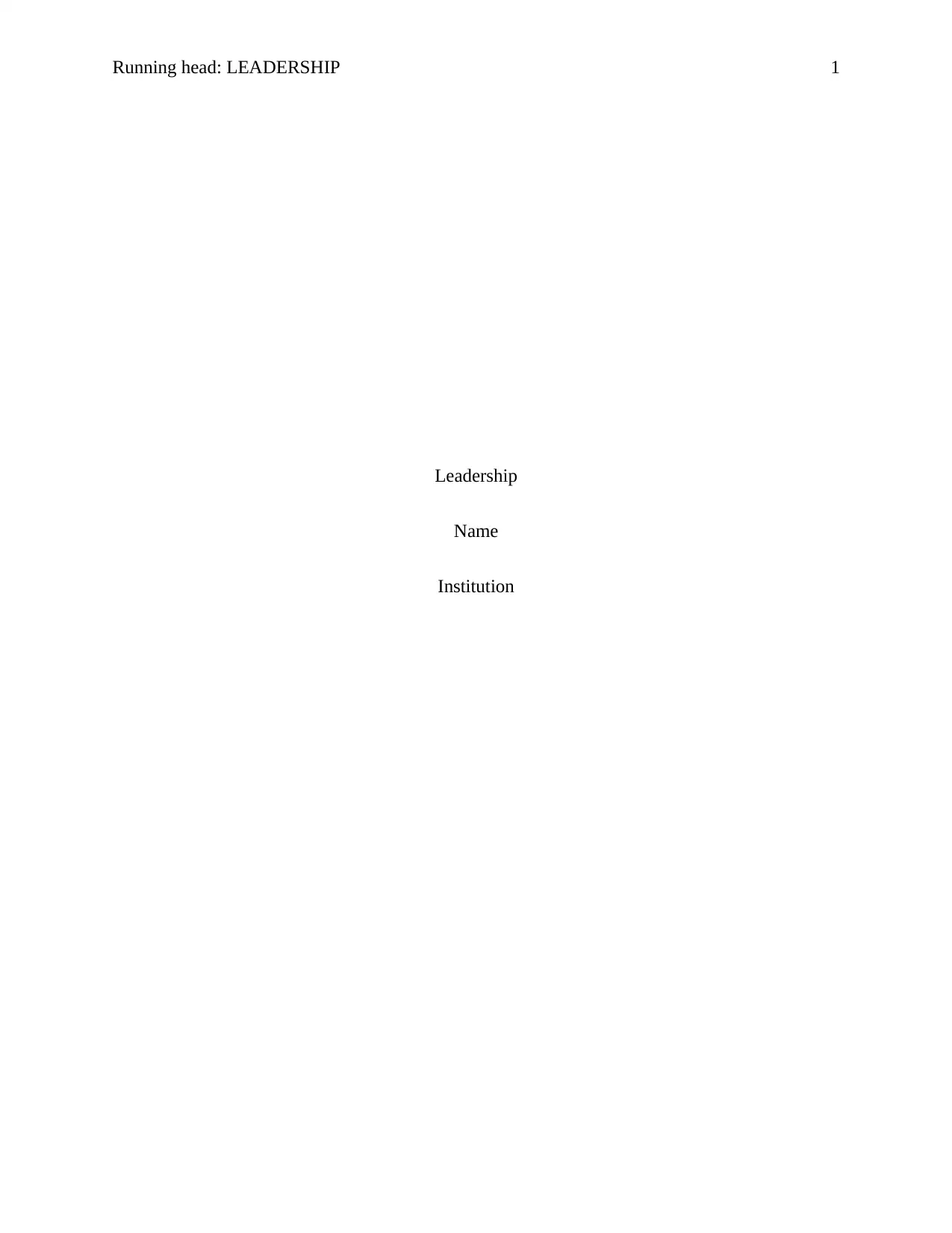
Running head: LEADERSHIP 1
Leadership
Name
Institution
Leadership
Name
Institution
Paraphrase This Document
Need a fresh take? Get an instant paraphrase of this document with our AI Paraphraser
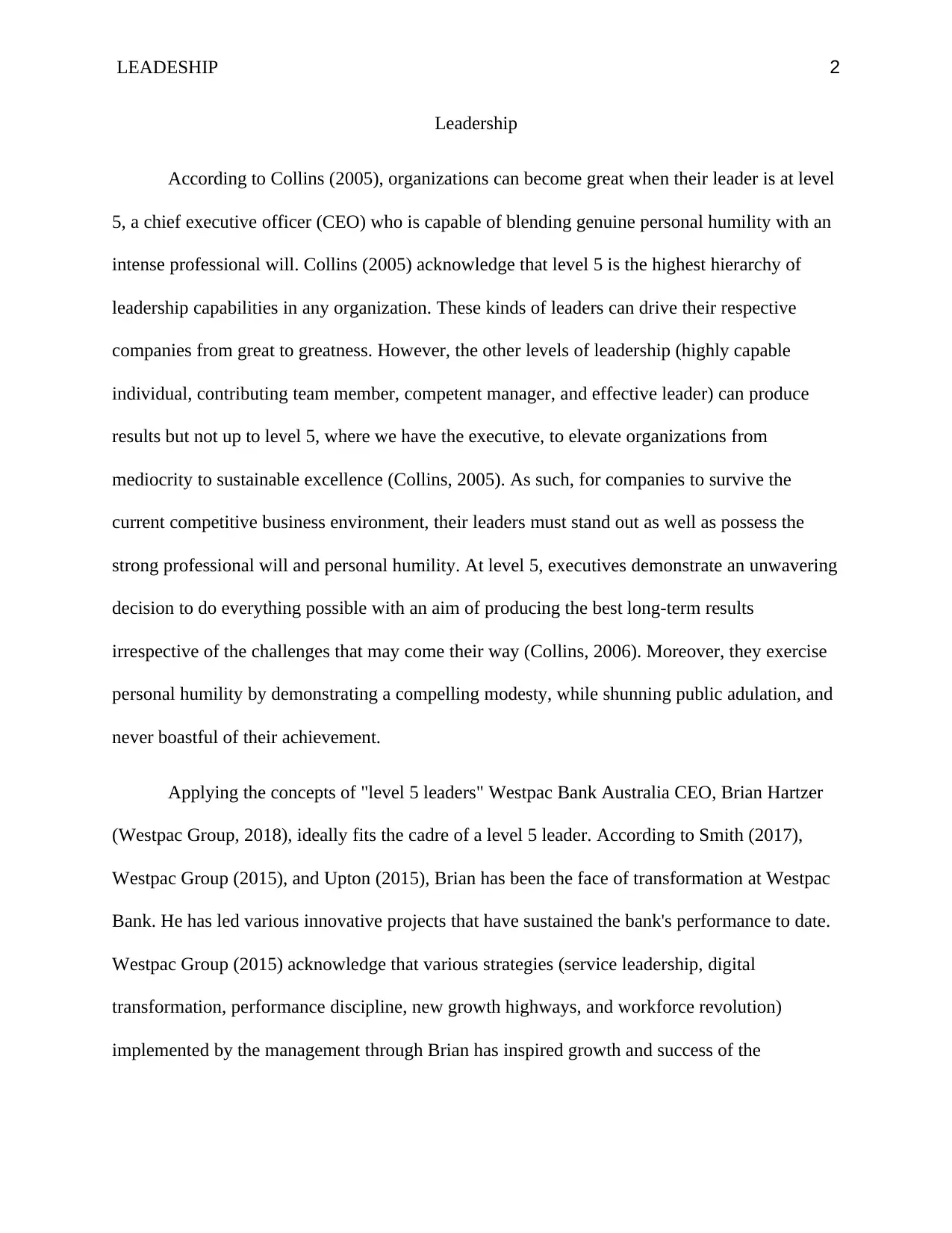
LEADESHIP 2
Leadership
According to Collins (2005), organizations can become great when their leader is at level
5, a chief executive officer (CEO) who is capable of blending genuine personal humility with an
intense professional will. Collins (2005) acknowledge that level 5 is the highest hierarchy of
leadership capabilities in any organization. These kinds of leaders can drive their respective
companies from great to greatness. However, the other levels of leadership (highly capable
individual, contributing team member, competent manager, and effective leader) can produce
results but not up to level 5, where we have the executive, to elevate organizations from
mediocrity to sustainable excellence (Collins, 2005). As such, for companies to survive the
current competitive business environment, their leaders must stand out as well as possess the
strong professional will and personal humility. At level 5, executives demonstrate an unwavering
decision to do everything possible with an aim of producing the best long-term results
irrespective of the challenges that may come their way (Collins, 2006). Moreover, they exercise
personal humility by demonstrating a compelling modesty, while shunning public adulation, and
never boastful of their achievement.
Applying the concepts of "level 5 leaders" Westpac Bank Australia CEO, Brian Hartzer
(Westpac Group, 2018), ideally fits the cadre of a level 5 leader. According to Smith (2017),
Westpac Group (2015), and Upton (2015), Brian has been the face of transformation at Westpac
Bank. He has led various innovative projects that have sustained the bank's performance to date.
Westpac Group (2015) acknowledge that various strategies (service leadership, digital
transformation, performance discipline, new growth highways, and workforce revolution)
implemented by the management through Brian has inspired growth and success of the
Leadership
According to Collins (2005), organizations can become great when their leader is at level
5, a chief executive officer (CEO) who is capable of blending genuine personal humility with an
intense professional will. Collins (2005) acknowledge that level 5 is the highest hierarchy of
leadership capabilities in any organization. These kinds of leaders can drive their respective
companies from great to greatness. However, the other levels of leadership (highly capable
individual, contributing team member, competent manager, and effective leader) can produce
results but not up to level 5, where we have the executive, to elevate organizations from
mediocrity to sustainable excellence (Collins, 2005). As such, for companies to survive the
current competitive business environment, their leaders must stand out as well as possess the
strong professional will and personal humility. At level 5, executives demonstrate an unwavering
decision to do everything possible with an aim of producing the best long-term results
irrespective of the challenges that may come their way (Collins, 2006). Moreover, they exercise
personal humility by demonstrating a compelling modesty, while shunning public adulation, and
never boastful of their achievement.
Applying the concepts of "level 5 leaders" Westpac Bank Australia CEO, Brian Hartzer
(Westpac Group, 2018), ideally fits the cadre of a level 5 leader. According to Smith (2017),
Westpac Group (2015), and Upton (2015), Brian has been the face of transformation at Westpac
Bank. He has led various innovative projects that have sustained the bank's performance to date.
Westpac Group (2015) acknowledge that various strategies (service leadership, digital
transformation, performance discipline, new growth highways, and workforce revolution)
implemented by the management through Brian has inspired growth and success of the
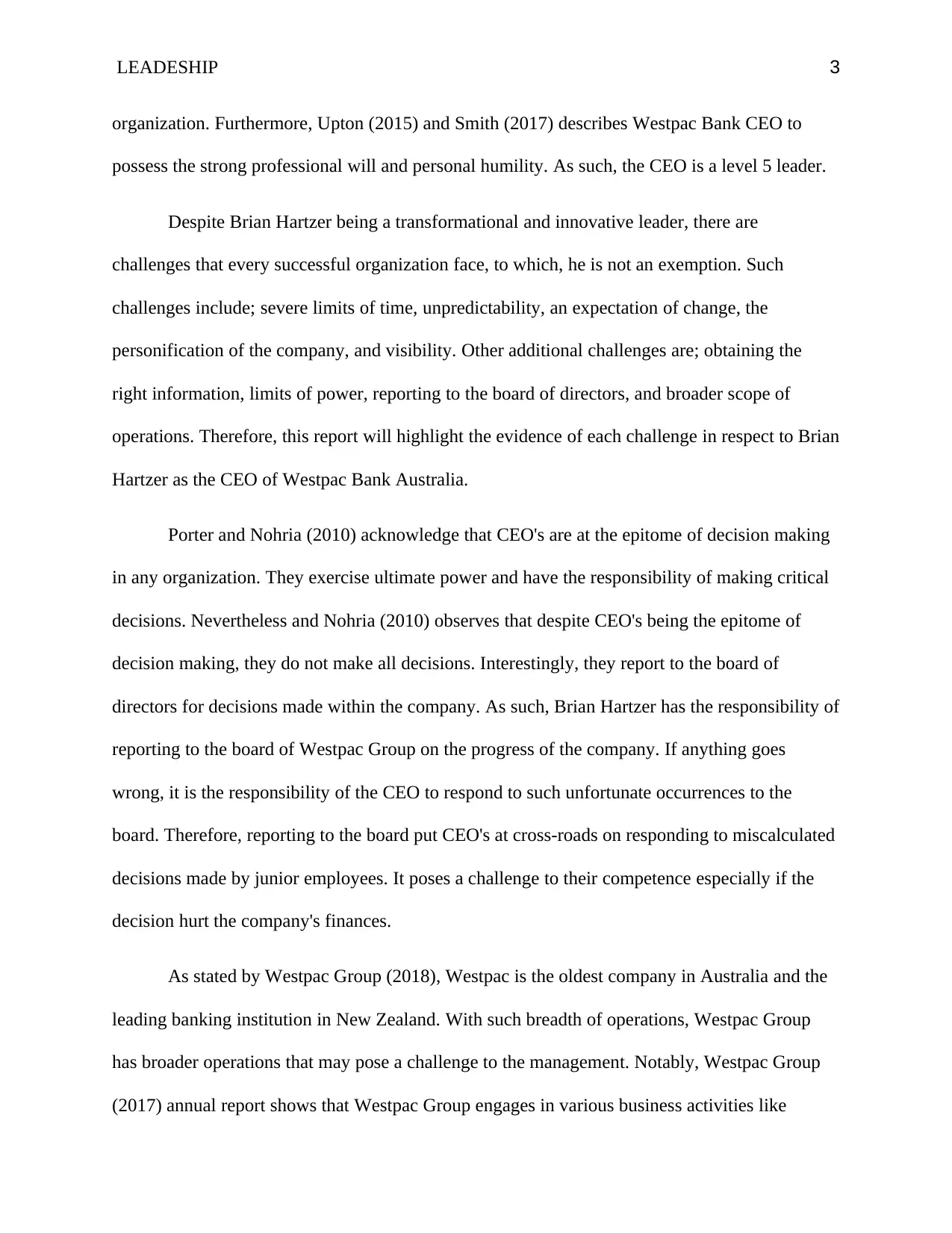
LEADESHIP 3
organization. Furthermore, Upton (2015) and Smith (2017) describes Westpac Bank CEO to
possess the strong professional will and personal humility. As such, the CEO is a level 5 leader.
Despite Brian Hartzer being a transformational and innovative leader, there are
challenges that every successful organization face, to which, he is not an exemption. Such
challenges include; severe limits of time, unpredictability, an expectation of change, the
personification of the company, and visibility. Other additional challenges are; obtaining the
right information, limits of power, reporting to the board of directors, and broader scope of
operations. Therefore, this report will highlight the evidence of each challenge in respect to Brian
Hartzer as the CEO of Westpac Bank Australia.
Porter and Nohria (2010) acknowledge that CEO's are at the epitome of decision making
in any organization. They exercise ultimate power and have the responsibility of making critical
decisions. Nevertheless and Nohria (2010) observes that despite CEO's being the epitome of
decision making, they do not make all decisions. Interestingly, they report to the board of
directors for decisions made within the company. As such, Brian Hartzer has the responsibility of
reporting to the board of Westpac Group on the progress of the company. If anything goes
wrong, it is the responsibility of the CEO to respond to such unfortunate occurrences to the
board. Therefore, reporting to the board put CEO's at cross-roads on responding to miscalculated
decisions made by junior employees. It poses a challenge to their competence especially if the
decision hurt the company's finances.
As stated by Westpac Group (2018), Westpac is the oldest company in Australia and the
leading banking institution in New Zealand. With such breadth of operations, Westpac Group
has broader operations that may pose a challenge to the management. Notably, Westpac Group
(2017) annual report shows that Westpac Group engages in various business activities like
organization. Furthermore, Upton (2015) and Smith (2017) describes Westpac Bank CEO to
possess the strong professional will and personal humility. As such, the CEO is a level 5 leader.
Despite Brian Hartzer being a transformational and innovative leader, there are
challenges that every successful organization face, to which, he is not an exemption. Such
challenges include; severe limits of time, unpredictability, an expectation of change, the
personification of the company, and visibility. Other additional challenges are; obtaining the
right information, limits of power, reporting to the board of directors, and broader scope of
operations. Therefore, this report will highlight the evidence of each challenge in respect to Brian
Hartzer as the CEO of Westpac Bank Australia.
Porter and Nohria (2010) acknowledge that CEO's are at the epitome of decision making
in any organization. They exercise ultimate power and have the responsibility of making critical
decisions. Nevertheless and Nohria (2010) observes that despite CEO's being the epitome of
decision making, they do not make all decisions. Interestingly, they report to the board of
directors for decisions made within the company. As such, Brian Hartzer has the responsibility of
reporting to the board of Westpac Group on the progress of the company. If anything goes
wrong, it is the responsibility of the CEO to respond to such unfortunate occurrences to the
board. Therefore, reporting to the board put CEO's at cross-roads on responding to miscalculated
decisions made by junior employees. It poses a challenge to their competence especially if the
decision hurt the company's finances.
As stated by Westpac Group (2018), Westpac is the oldest company in Australia and the
leading banking institution in New Zealand. With such breadth of operations, Westpac Group
has broader operations that may pose a challenge to the management. Notably, Westpac Group
(2017) annual report shows that Westpac Group engages in various business activities like
⊘ This is a preview!⊘
Do you want full access?
Subscribe today to unlock all pages.

Trusted by 1+ million students worldwide
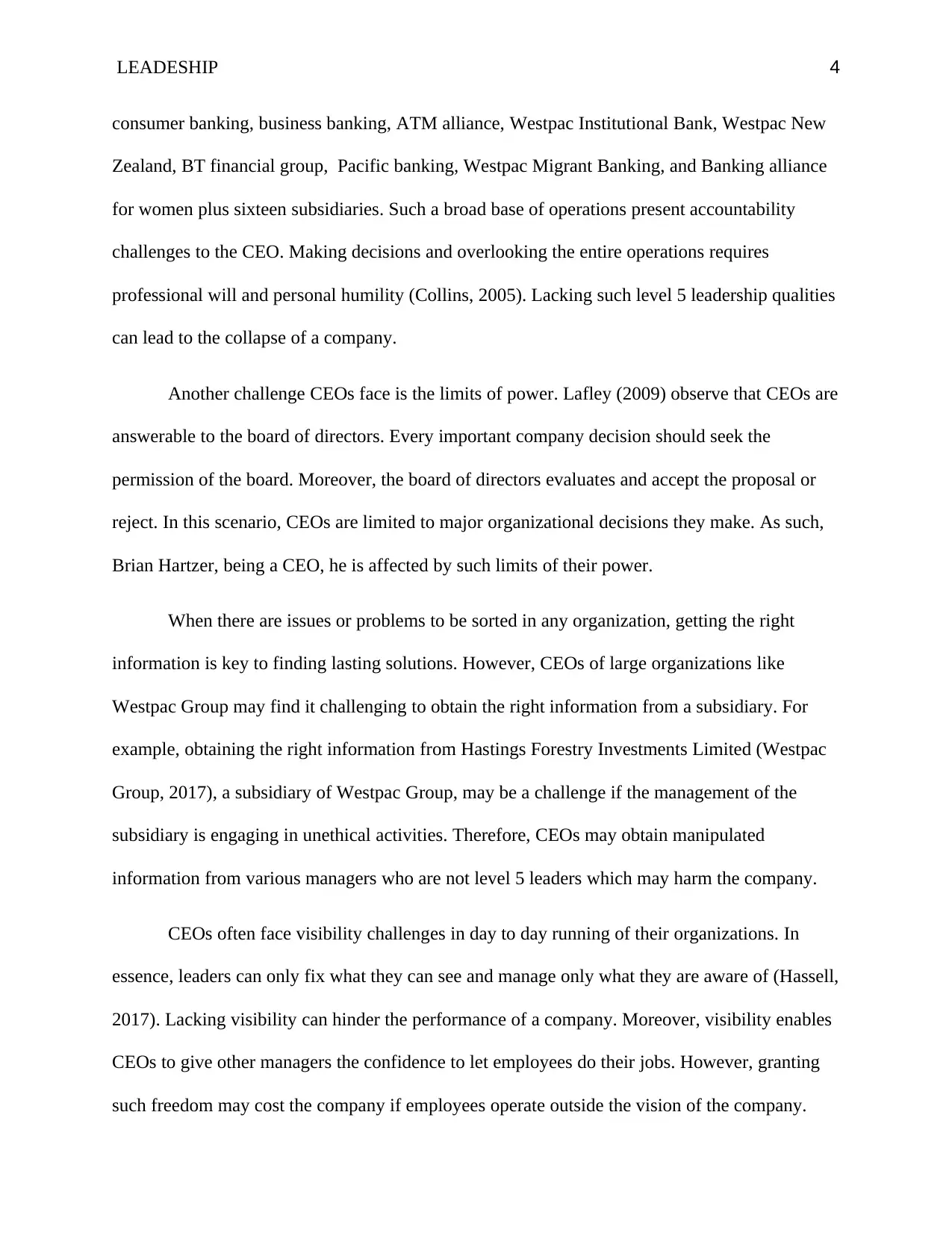
LEADESHIP 4
consumer banking, business banking, ATM alliance, Westpac Institutional Bank, Westpac New
Zealand, BT financial group, Pacific banking, Westpac Migrant Banking, and Banking alliance
for women plus sixteen subsidiaries. Such a broad base of operations present accountability
challenges to the CEO. Making decisions and overlooking the entire operations requires
professional will and personal humility (Collins, 2005). Lacking such level 5 leadership qualities
can lead to the collapse of a company.
Another challenge CEOs face is the limits of power. Lafley (2009) observe that CEOs are
answerable to the board of directors. Every important company decision should seek the
permission of the board. Moreover, the board of directors evaluates and accept the proposal or
reject. In this scenario, CEOs are limited to major organizational decisions they make. As such,
Brian Hartzer, being a CEO, he is affected by such limits of their power.
When there are issues or problems to be sorted in any organization, getting the right
information is key to finding lasting solutions. However, CEOs of large organizations like
Westpac Group may find it challenging to obtain the right information from a subsidiary. For
example, obtaining the right information from Hastings Forestry Investments Limited (Westpac
Group, 2017), a subsidiary of Westpac Group, may be a challenge if the management of the
subsidiary is engaging in unethical activities. Therefore, CEOs may obtain manipulated
information from various managers who are not level 5 leaders which may harm the company.
CEOs often face visibility challenges in day to day running of their organizations. In
essence, leaders can only fix what they can see and manage only what they are aware of (Hassell,
2017). Lacking visibility can hinder the performance of a company. Moreover, visibility enables
CEOs to give other managers the confidence to let employees do their jobs. However, granting
such freedom may cost the company if employees operate outside the vision of the company.
consumer banking, business banking, ATM alliance, Westpac Institutional Bank, Westpac New
Zealand, BT financial group, Pacific banking, Westpac Migrant Banking, and Banking alliance
for women plus sixteen subsidiaries. Such a broad base of operations present accountability
challenges to the CEO. Making decisions and overlooking the entire operations requires
professional will and personal humility (Collins, 2005). Lacking such level 5 leadership qualities
can lead to the collapse of a company.
Another challenge CEOs face is the limits of power. Lafley (2009) observe that CEOs are
answerable to the board of directors. Every important company decision should seek the
permission of the board. Moreover, the board of directors evaluates and accept the proposal or
reject. In this scenario, CEOs are limited to major organizational decisions they make. As such,
Brian Hartzer, being a CEO, he is affected by such limits of their power.
When there are issues or problems to be sorted in any organization, getting the right
information is key to finding lasting solutions. However, CEOs of large organizations like
Westpac Group may find it challenging to obtain the right information from a subsidiary. For
example, obtaining the right information from Hastings Forestry Investments Limited (Westpac
Group, 2017), a subsidiary of Westpac Group, may be a challenge if the management of the
subsidiary is engaging in unethical activities. Therefore, CEOs may obtain manipulated
information from various managers who are not level 5 leaders which may harm the company.
CEOs often face visibility challenges in day to day running of their organizations. In
essence, leaders can only fix what they can see and manage only what they are aware of (Hassell,
2017). Lacking visibility can hinder the performance of a company. Moreover, visibility enables
CEOs to give other managers the confidence to let employees do their jobs. However, granting
such freedom may cost the company if employees operate outside the vision of the company.
Paraphrase This Document
Need a fresh take? Get an instant paraphrase of this document with our AI Paraphraser
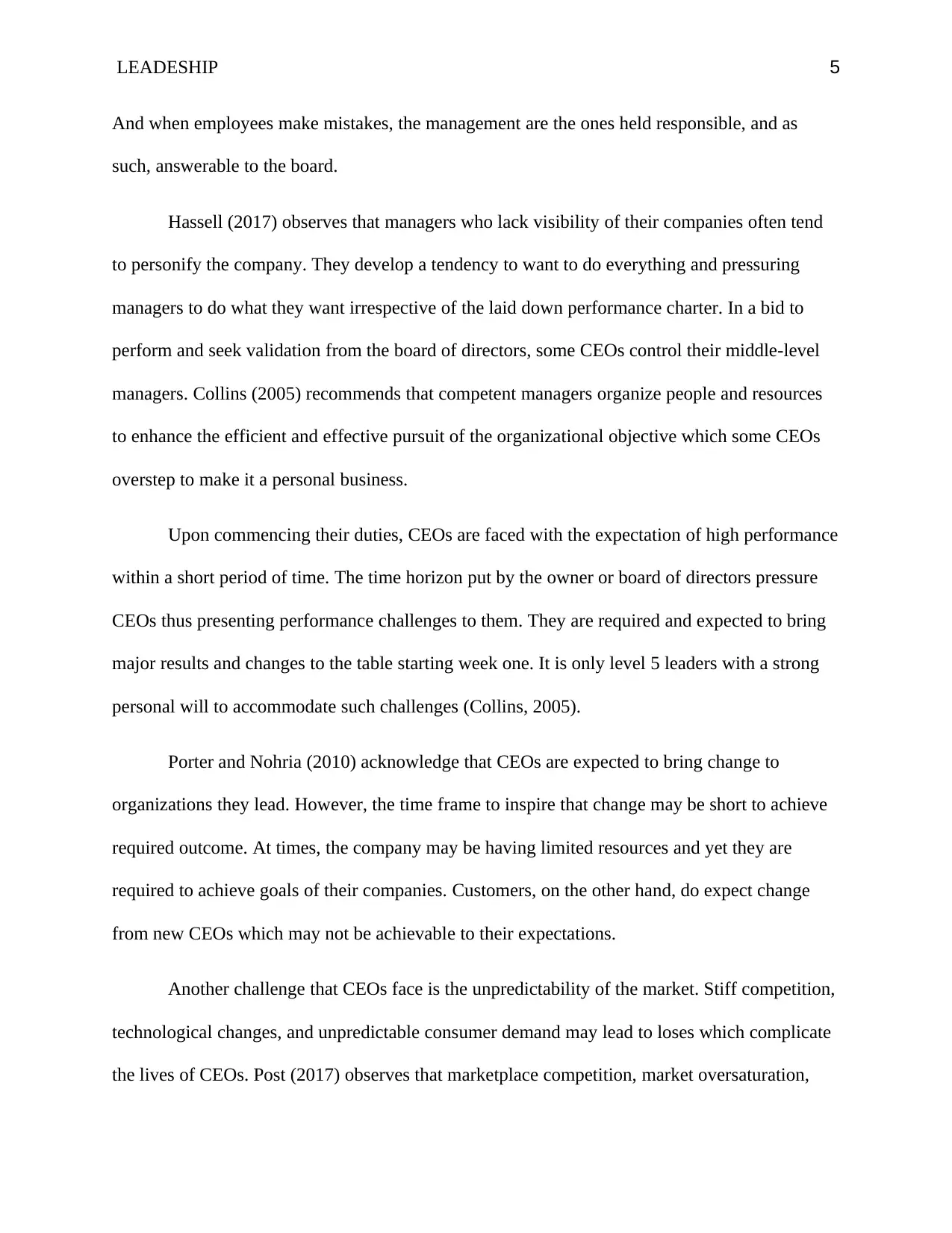
LEADESHIP 5
And when employees make mistakes, the management are the ones held responsible, and as
such, answerable to the board.
Hassell (2017) observes that managers who lack visibility of their companies often tend
to personify the company. They develop a tendency to want to do everything and pressuring
managers to do what they want irrespective of the laid down performance charter. In a bid to
perform and seek validation from the board of directors, some CEOs control their middle-level
managers. Collins (2005) recommends that competent managers organize people and resources
to enhance the efficient and effective pursuit of the organizational objective which some CEOs
overstep to make it a personal business.
Upon commencing their duties, CEOs are faced with the expectation of high performance
within a short period of time. The time horizon put by the owner or board of directors pressure
CEOs thus presenting performance challenges to them. They are required and expected to bring
major results and changes to the table starting week one. It is only level 5 leaders with a strong
personal will to accommodate such challenges (Collins, 2005).
Porter and Nohria (2010) acknowledge that CEOs are expected to bring change to
organizations they lead. However, the time frame to inspire that change may be short to achieve
required outcome. At times, the company may be having limited resources and yet they are
required to achieve goals of their companies. Customers, on the other hand, do expect change
from new CEOs which may not be achievable to their expectations.
Another challenge that CEOs face is the unpredictability of the market. Stiff competition,
technological changes, and unpredictable consumer demand may lead to loses which complicate
the lives of CEOs. Post (2017) observes that marketplace competition, market oversaturation,
And when employees make mistakes, the management are the ones held responsible, and as
such, answerable to the board.
Hassell (2017) observes that managers who lack visibility of their companies often tend
to personify the company. They develop a tendency to want to do everything and pressuring
managers to do what they want irrespective of the laid down performance charter. In a bid to
perform and seek validation from the board of directors, some CEOs control their middle-level
managers. Collins (2005) recommends that competent managers organize people and resources
to enhance the efficient and effective pursuit of the organizational objective which some CEOs
overstep to make it a personal business.
Upon commencing their duties, CEOs are faced with the expectation of high performance
within a short period of time. The time horizon put by the owner or board of directors pressure
CEOs thus presenting performance challenges to them. They are required and expected to bring
major results and changes to the table starting week one. It is only level 5 leaders with a strong
personal will to accommodate such challenges (Collins, 2005).
Porter and Nohria (2010) acknowledge that CEOs are expected to bring change to
organizations they lead. However, the time frame to inspire that change may be short to achieve
required outcome. At times, the company may be having limited resources and yet they are
required to achieve goals of their companies. Customers, on the other hand, do expect change
from new CEOs which may not be achievable to their expectations.
Another challenge that CEOs face is the unpredictability of the market. Stiff competition,
technological changes, and unpredictable consumer demand may lead to loses which complicate
the lives of CEOs. Post (2017) observes that marketplace competition, market oversaturation,
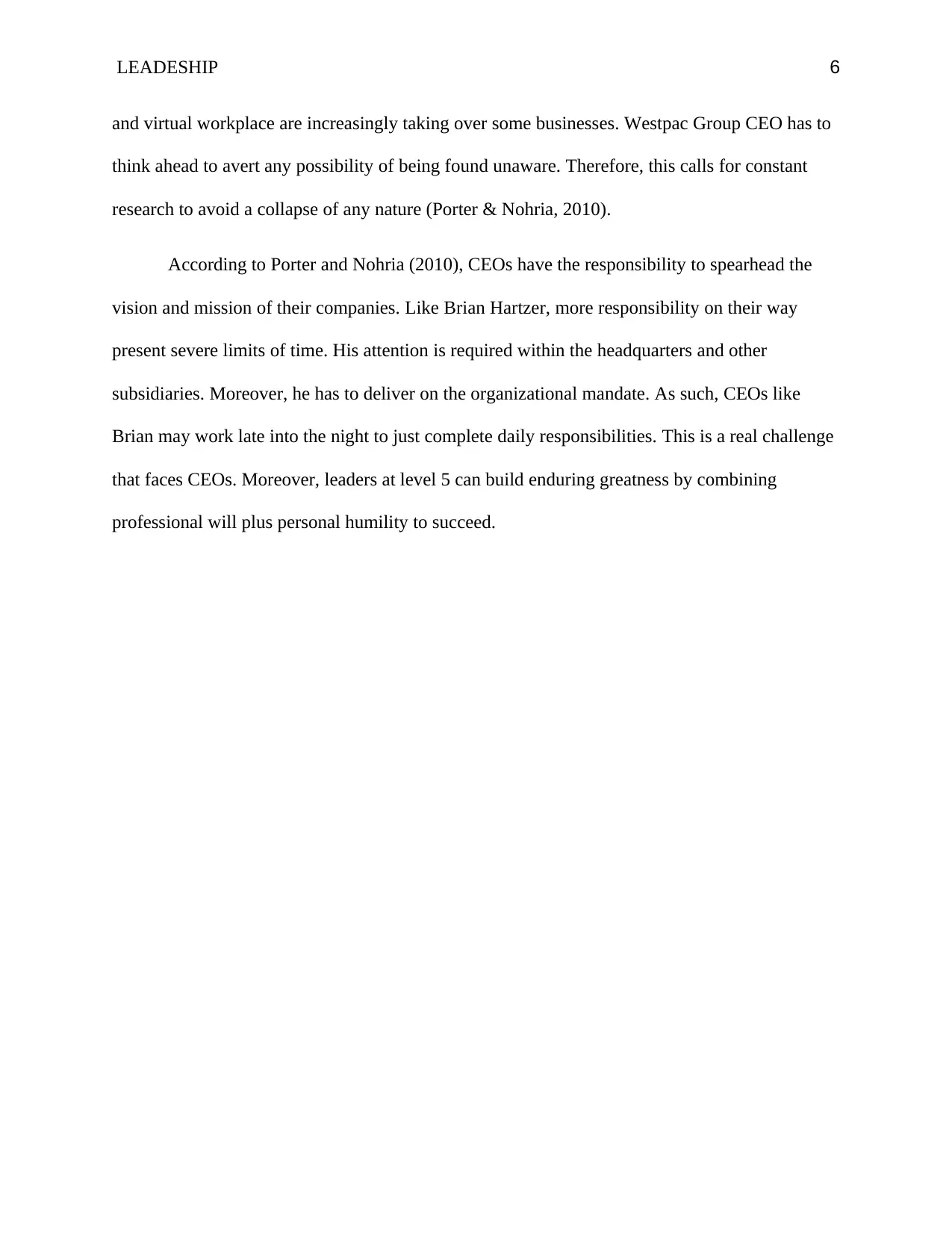
LEADESHIP 6
and virtual workplace are increasingly taking over some businesses. Westpac Group CEO has to
think ahead to avert any possibility of being found unaware. Therefore, this calls for constant
research to avoid a collapse of any nature (Porter & Nohria, 2010).
According to Porter and Nohria (2010), CEOs have the responsibility to spearhead the
vision and mission of their companies. Like Brian Hartzer, more responsibility on their way
present severe limits of time. His attention is required within the headquarters and other
subsidiaries. Moreover, he has to deliver on the organizational mandate. As such, CEOs like
Brian may work late into the night to just complete daily responsibilities. This is a real challenge
that faces CEOs. Moreover, leaders at level 5 can build enduring greatness by combining
professional will plus personal humility to succeed.
and virtual workplace are increasingly taking over some businesses. Westpac Group CEO has to
think ahead to avert any possibility of being found unaware. Therefore, this calls for constant
research to avoid a collapse of any nature (Porter & Nohria, 2010).
According to Porter and Nohria (2010), CEOs have the responsibility to spearhead the
vision and mission of their companies. Like Brian Hartzer, more responsibility on their way
present severe limits of time. His attention is required within the headquarters and other
subsidiaries. Moreover, he has to deliver on the organizational mandate. As such, CEOs like
Brian may work late into the night to just complete daily responsibilities. This is a real challenge
that faces CEOs. Moreover, leaders at level 5 can build enduring greatness by combining
professional will plus personal humility to succeed.
⊘ This is a preview!⊘
Do you want full access?
Subscribe today to unlock all pages.

Trusted by 1+ million students worldwide
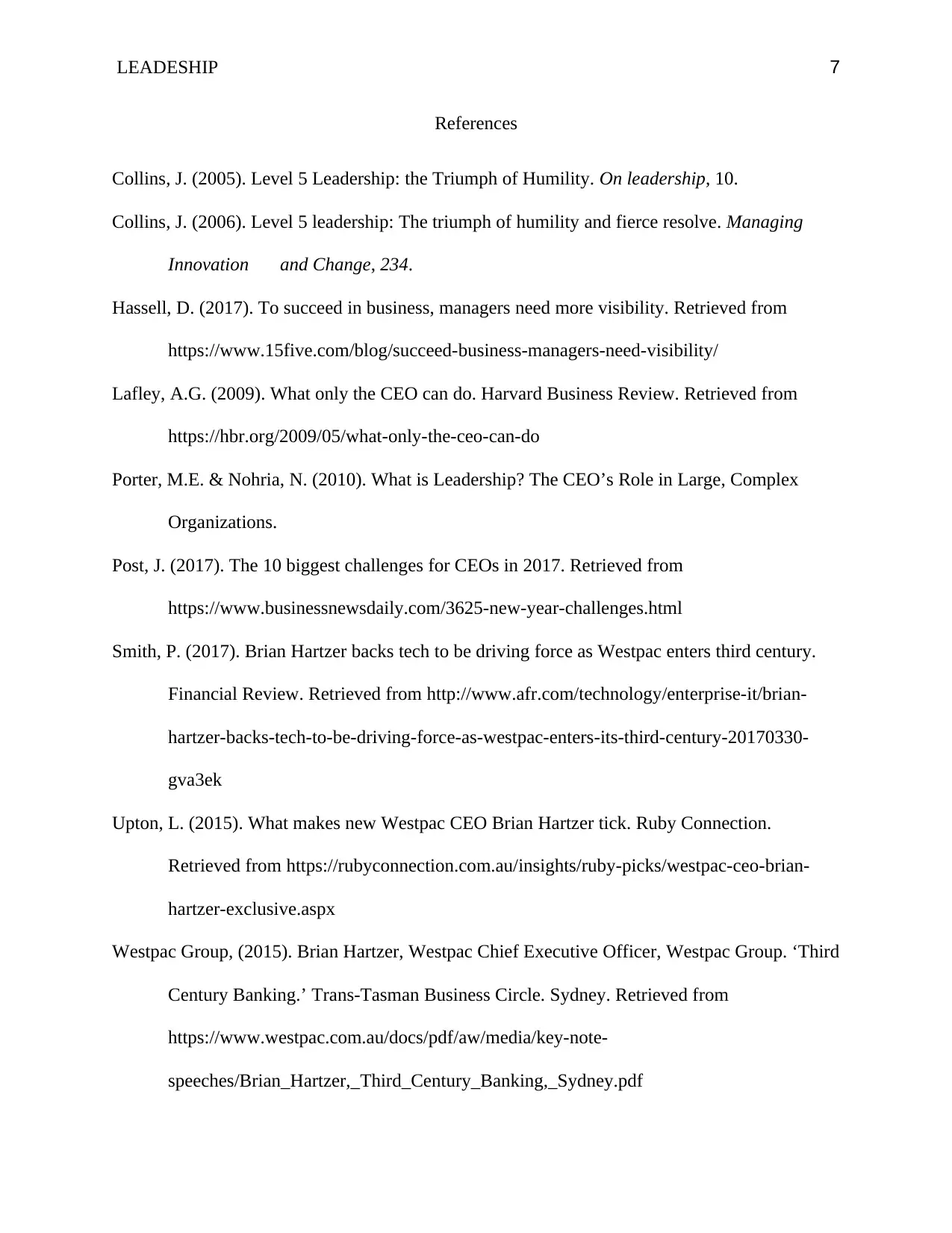
LEADESHIP 7
References
Collins, J. (2005). Level 5 Leadership: the Triumph of Humility. On leadership, 10.
Collins, J. (2006). Level 5 leadership: The triumph of humility and fierce resolve. Managing
Innovation and Change, 234.
Hassell, D. (2017). To succeed in business, managers need more visibility. Retrieved from
https://www.15five.com/blog/succeed-business-managers-need-visibility/
Lafley, A.G. (2009). What only the CEO can do. Harvard Business Review. Retrieved from
https://hbr.org/2009/05/what-only-the-ceo-can-do
Porter, M.E. & Nohria, N. (2010). What is Leadership? The CEO’s Role in Large, Complex
Organizations.
Post, J. (2017). The 10 biggest challenges for CEOs in 2017. Retrieved from
https://www.businessnewsdaily.com/3625-new-year-challenges.html
Smith, P. (2017). Brian Hartzer backs tech to be driving force as Westpac enters third century.
Financial Review. Retrieved from http://www.afr.com/technology/enterprise-it/brian-
hartzer-backs-tech-to-be-driving-force-as-westpac-enters-its-third-century-20170330-
gva3ek
Upton, L. (2015). What makes new Westpac CEO Brian Hartzer tick. Ruby Connection.
Retrieved from https://rubyconnection.com.au/insights/ruby-picks/westpac-ceo-brian-
hartzer-exclusive.aspx
Westpac Group, (2015). Brian Hartzer, Westpac Chief Executive Officer, Westpac Group. ‘Third
Century Banking.’ Trans-Tasman Business Circle. Sydney. Retrieved from
https://www.westpac.com.au/docs/pdf/aw/media/key-note-
speeches/Brian_Hartzer,_Third_Century_Banking,_Sydney.pdf
References
Collins, J. (2005). Level 5 Leadership: the Triumph of Humility. On leadership, 10.
Collins, J. (2006). Level 5 leadership: The triumph of humility and fierce resolve. Managing
Innovation and Change, 234.
Hassell, D. (2017). To succeed in business, managers need more visibility. Retrieved from
https://www.15five.com/blog/succeed-business-managers-need-visibility/
Lafley, A.G. (2009). What only the CEO can do. Harvard Business Review. Retrieved from
https://hbr.org/2009/05/what-only-the-ceo-can-do
Porter, M.E. & Nohria, N. (2010). What is Leadership? The CEO’s Role in Large, Complex
Organizations.
Post, J. (2017). The 10 biggest challenges for CEOs in 2017. Retrieved from
https://www.businessnewsdaily.com/3625-new-year-challenges.html
Smith, P. (2017). Brian Hartzer backs tech to be driving force as Westpac enters third century.
Financial Review. Retrieved from http://www.afr.com/technology/enterprise-it/brian-
hartzer-backs-tech-to-be-driving-force-as-westpac-enters-its-third-century-20170330-
gva3ek
Upton, L. (2015). What makes new Westpac CEO Brian Hartzer tick. Ruby Connection.
Retrieved from https://rubyconnection.com.au/insights/ruby-picks/westpac-ceo-brian-
hartzer-exclusive.aspx
Westpac Group, (2015). Brian Hartzer, Westpac Chief Executive Officer, Westpac Group. ‘Third
Century Banking.’ Trans-Tasman Business Circle. Sydney. Retrieved from
https://www.westpac.com.au/docs/pdf/aw/media/key-note-
speeches/Brian_Hartzer,_Third_Century_Banking,_Sydney.pdf
Paraphrase This Document
Need a fresh take? Get an instant paraphrase of this document with our AI Paraphraser
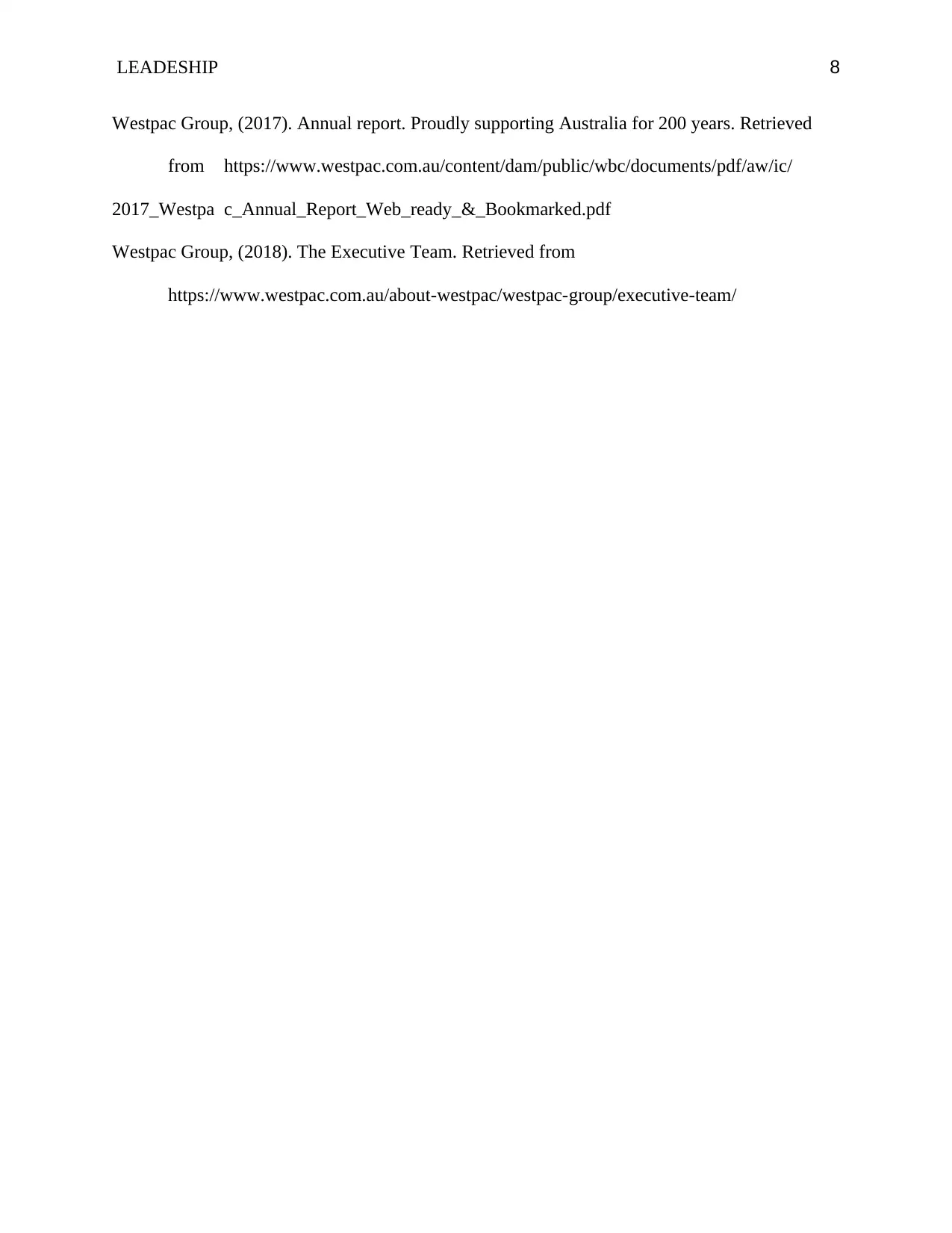
LEADESHIP 8
Westpac Group, (2017). Annual report. Proudly supporting Australia for 200 years. Retrieved
from https://www.westpac.com.au/content/dam/public/wbc/documents/pdf/aw/ic/
2017_Westpa c_Annual_Report_Web_ready_&_Bookmarked.pdf
Westpac Group, (2018). The Executive Team. Retrieved from
https://www.westpac.com.au/about-westpac/westpac-group/executive-team/
Westpac Group, (2017). Annual report. Proudly supporting Australia for 200 years. Retrieved
from https://www.westpac.com.au/content/dam/public/wbc/documents/pdf/aw/ic/
2017_Westpa c_Annual_Report_Web_ready_&_Bookmarked.pdf
Westpac Group, (2018). The Executive Team. Retrieved from
https://www.westpac.com.au/about-westpac/westpac-group/executive-team/
1 out of 8
Your All-in-One AI-Powered Toolkit for Academic Success.
+13062052269
info@desklib.com
Available 24*7 on WhatsApp / Email
![[object Object]](/_next/static/media/star-bottom.7253800d.svg)
Unlock your academic potential
Copyright © 2020–2025 A2Z Services. All Rights Reserved. Developed and managed by ZUCOL.
